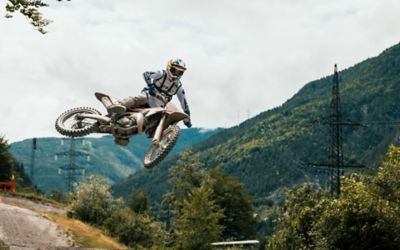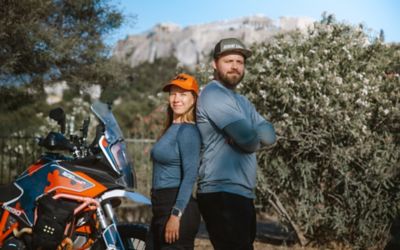
Three of the four Red Bull KTM MotoGP™ racers rely on Alpinestars’ suit and Tech-Air airbag technology when they are doing their business on the KTM RC16. But how different and how personalized are these official ‘clothes’?
By Adam Wheeler
Up close, MotoGP race suits are complex and fascinating garments. They involve a patchwork construction of different fabrics and Kangaroo leather panels. They contain assorted materials to guard against the grind and burn of asphalt and gravel at ridiculous speed. They are formed of bumps and protrusions that hide cutting-edge technology – like airbags - that can sense a crash and fire in 0.4 of a second. Riders that finish on the podium on Sunday will be wearing these threads for the better part of four hours. For all their safety capabilities and the additions of Kevlar, PVC and other armor-like elements the suits are manageable, almost comfortable. Special work uniforms.
Pedro Acosta, Enea Bastianini and Maverick Viñales all count on the experience and trackside expertise of Alpinestars to protect their skin with a second ‘skin’. As former world champions and Grand Prix winners the trio are competing at elite level, so naturally their suits are made-to-measure (the length and thickness of limbs, hips, chest and back) but they are also remarkably close to the company’s top spec customer suit: the Racing Absolute V2. The two Spaniards and Italian are vaguely similar in terms of body shape and size, but we decided to speak to Alpinestars Media Manager Chris Hillard and William Mitham, MotoGP Athlete Manager, to find out how (and why) they get even more personalized.
“A MotoGP suit is a customized version of the Racing Absolute V2. Even our standard product for the public is made from a paper pattern of around 80 pieces of kangaroo leather,” Hillard explains. “And on top of that is another 75 components to bring it all together: from the protectors, the threads, the Kevlar.”
Acosta, Bastianini and Viñales will have the same thickness of leather. “We have a minimum tolerance,” says Mitham. All three riders will also use the same undersuit that helps the body manage temperature, sweat and insulation but then they start to diverge slightly. “Maverick is really focused on safety so it is really important for him to have the most up-to-date products and technology inside,” Hillard reveals. “The other two also want the best possible protection but they are a bit more relaxed. For example, Maverick pushed for triple stitching on the seams. He was the first to develop that and now all the others use it. You can see it around the legs, and it made the suit even stronger in the event of a crash and when the leather is being pulled around.”
“All the riders and personalities that we work with they have different goals at different times,” Chris continues. “Sometimes it takes a crash and an injury for a rider to think even more about protection. Sometimes they worry more about their performance and something like shedding as much weight as possible. Our program in the paddock is able to harness the needs of each rider. It’s great when someone like Maverick is always open about new ideas for safety. It makes him a good tester. Some riders are happy for others to do the testing and then take on a new feature once it’s been developed.”
One of easiest differences to detect is through the rear hump. “Each rider uses a different shape configured to their helmet and the spoiler,” Mitham says. “Maverick and Pedro have the same because it was modelled to Pedro’s Alpinestars’ Supertech R10 helmet and Maverick’s Arai is quite similar. The hump is optimized to the SR10 but that doesn’t mean it won’t fit other helmets. Enea’s hump is more squared to accommodate his helmet brand.”
The hump is part of the rider’s personal aerodynamic profile. The airflow potential means that suits are now tighter than they have ever been and that throws more importance onto their flexibility. “The hump is the prime visual example and a benefit of being able to do wind tunnel testing with the likes of Red Bull KTM but, to be honest, there are small solutions all over the suit to help reduce drag,” offers Hillard.
“We want the suit to be as flat around the rider as possible,” emphasizes Mitham. “We want to avoid ripple, so now we are working on a secret material underneath the leather to almost suck it to the rider, creating a solid shape.”
Thanks to the phenomenal adhesion of modern MotoGP tires, sliders for elbows are now as prominent as those for knees. Well, for some riders at least. “The standard suit has an elbow protector and elbow slider but Pedro and Enea have extra material because we saw they were saving a lot of crashes with their arms and the suit was getting quite damaged,” Hillard says.
“The elbow section still has to be flexible because when they are saving the bike they are stretching up,” Mitham offers, holding up the suits. “Pedro has the maximum in this area and, in contrast, Maverick has the minimum! Enea is somewhere in the middle…but we have many configurations. We have three different interchangeable elbow compounds and then the additional parts to cover the part when they are dragging.”
The 2025 season-opening Grand Prix in Thailand saw near 40-degree temperatures and one of the hottest races in recent memory. Alpinestars were able to react quickly for more individual touches. “We have heat deflecting material in some areas,” says Mitham. “In Thailand we had an issue where the Red Bull KTM Tech3 riders were feeling the [bike] heat, so we added material that we sometimes put into the boots because it gets quite hot around the exhaust area. Maverick didn’t want it inside the leather because he could feel it rubbing on the undersuit, so we applied it on the outside. Enea didn’t have this problem.”
“This is part of having a racing service at the track,” Hillard underlines. “We get these challenges from the teams and we can communicate with all parties and find solutions at the Grand Prix. We implemented this measure after the Sprint on Saturday in Thailand and the guys had it already for the Grand Prix race on Sunday.”
Acosta, Bastianini and Viñales will have their personal logos (all three seem to run graphics in dedication to other riders around the hump) and they will also have choices when it comes to the airbag that covers the back, chest shoulders and hips when deployed. “We offer two charges but it’s down to the rider if they want one or two because it’s all about weight again,” Hillard offers. “We would prefer that they use two canisters…but we understand that they want to carry less weight and be protected for one crash.”
Lastly Alpinestars cater to the whims and (occasionally strange) customs of their athletes. “Maverick doesn’t mind changing his gear but Enea likes to start and finish the same weekend with the same suit,” Mitham smiles. “Pedro is quite superstitious and always wants the same suit as much as possible. He also puts something special inside the hump: a piece of garlic!” Garlic for ‘The Shark’? Pedro will certainly be keeping the teeth of a vampire at bay.

